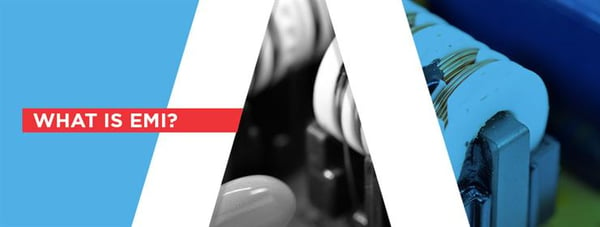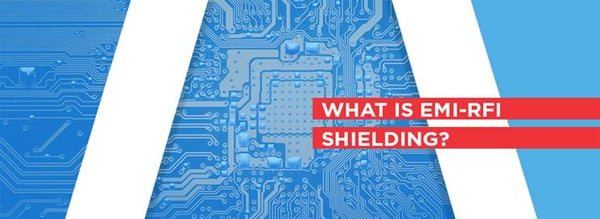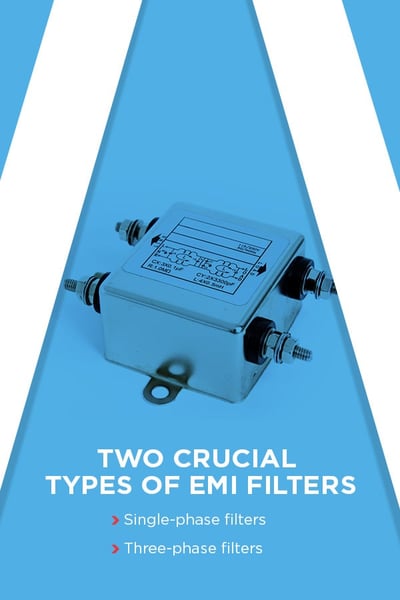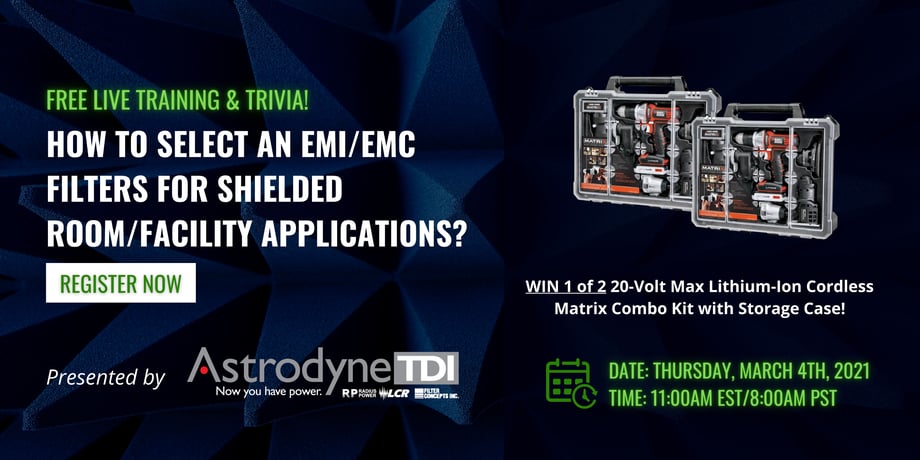RESOURCES
EMI Shielding vs Filtering
As our world becomes more digital, and electronic devices continue to play increasingly central roles in our lives, electromagnetic interference, or EMI, becomes an increasingly important issue. Everyone who designs and manufactures electronic devices or components needs to be concerned with managing EMI.
Shielding and filtering are two primary methods of accomplishing this.
When electronic devices receive electromagnetic waves, they may cause electric currents to be induced in the circuit, causing interference and disrupting the intended operation of the device. If the energy is especially powerful, the electronic device may be damaged. Even if the power applied is relatively small, if it mixes with radio waves used for communication, it may cause loss of reception, disrupted video and abnormal noise in places where the radio waves are weak.
A quality electrical ground system can help minimize EMI problems.
Shields, filters, capacitors and inductors can also reduce a system's susceptibility to interference. When designing electronic devices, adding filters and shields can help control EMI. Both kinds of components provide noise suppression and can get used without adding significant size or cost to a device.
What is the difference between these two noise suppression methods, though, and when should you use them? Read on to find out.

What is EMI?
EMI is the disruption of the operation of an electronic product due to an electromagnetic field. EMI is also called radio frequency interference (RFI) when the field is in the radio frequency spectrum on the electromagnetic frequency spectrum. The electromagnetic waves that result in interference get referred to as electromagnetic noise.
Another related term to EMI is EMC, which stands for electromagnetic compatibility. This term refers to how well a device functions in an environment with electromagnetic noise.
A product's tolerance to noise, as well as how much it produces, both factor into its EMC.
To function and to allow other devices to work, every product must be able to operate even when exposed to a certain level of noise and must not produce EMI at levels that impede the function of the devices. In the United States, the Federal Communications Commission, or FCC, regulates EMI. The International Special Committee for Radio Interference regulates it internationally in some sectors.
Many other industry standards also set requirements related to EMC.
The circuits within personal computers create EM fields in the RF range. Cathode ray tube displays also produce EM energy over a range of frequencies.
If you use a wireless receiver at the same time as a personal computer, you'll likely hear RF noise in the receiver. Wireless transmitters also produce EM fields, and moderate and high-powered ones can create fields strong enough to disrupt electronic equipment operating in the area. If you use a radio or television transmitter near a broadcast station, for example, you may experience EMI.
Strong RF fields can cause phones, computers and even some medical devices to stop working correctly. Natural events such as electrical storms, solar flares and static electricity can also cause EMI. That's why EMI shielding and EMI filtering are so important.

How Does EMI Shielding Work?
What is EMI-RFI shielding?
EMI-RFI shielding refers to surrounding an object with a metal plate or some other form of protection to block electromagnetic fields. EMI shields are designed to prevent radiated emissions from getting past a certain point. EMI shielding solutions can both protect a device from external radiation and prevent that device from emitting radiation that could cause interference with other devices.
So, what happens when an EM wave hits an EMI shield?
Let's take a look at some basic EMI shielding principles.
The conductive surface of the shield reflects most of the energy from the EM wave in various directions. Exactly how the wave reflects depends on the qualities of the shield's material and the phase of the wave when it hits the shield. The EMI shield will also absorb some of the energy from the EM wave, which will get converted into heat energy.
Depending on the power levels involved, this heat energy may necessitate thermal management.
Some EMI shielding materials are made to double as heat sinks. In higher-power electronic circuits, especially when shielding mechanisms that absorb more energy get used, you may need to have openings in the metal sheets of the shield to release heat. The size of these holes shouldn't relate to the wavelengths of the waves being contained, as this may minimize EMI shielding effectiveness.
For shielding materials to work well, they also need good ground connections.
How do you choose which EMI-RFI shielding materials to use?
There are several vital parameters, including thickness, weight, material conductivity and tooling costs.
Thicker shields tend to provide better results, but this comes with the tradeoff of adding weight to the design. Most suppliers of shielding materials provide measures of effectiveness at different frequencies with the usable frequency ranges of the materials. These measurements help with comparing the weight and density of a shielding material to the amount of shielding it provides.
Other less common, but still potentially useful, parameters include volume resistivity, operating temperature range and compression force if using the material as a gasket.
Examples of materials commonly used for EMI shielding include:
- Copper
- Aluminum
- Stainless steel
More recently, manufacturers have also begun using composite materials, such as meshes and fabrics. These solutions often combine a metal with a polyester material. Some advantages of these newer materials are their light weight and flexibility. Despite their low weight, they still work.
EMI shielding applications in which these materials get used include shielding around printed circuit boards in an equipment enclosure and providing secondary shielding in healthcare settings.
Custom EMI shielding solutions, as well as off-the-shelf shielding products, are available.
How Does EMI Filtering Work?
EMI-RFI filters can remove unwanted components and let the necessary ones through in the electric current flowing in conductors. Noise gets diverted to the ground, absorbed or returned to its origin.
An EMI filter has two kinds of components — capacitors and inductors — that work together to reduce EMI:
- Capacitors: Capacitors inhibit direct current, which is how a substantial amount of electromagnetic interference gets carried into a device, but let the alternating current pass through.
- Inductors: Inductors are small electromagnets that can hold energy in a magnetic field as electric current passes through it, reducing the total voltage.
The capacitors found in EMI filters get referred to as shunting capacitors.
They redirect high-frequency current that would cause interference away from a circuit and feed it into inductors arranged in a series. As the current moves through this series of inductors, its voltage gets reduced. Ideally, the inductors will diminish the interference to nothing, which is also called shorting to ground.
The role of filters differs from that of shields in several ways.
Let's explore some basic EMI filtering principles.
EMI shields provide shielding for entire designs or circuits.
EMI suppression filters, on the other hand, target specific noise sources. Shields contain EM radiation within an area and also prevent EM radiation from entering that area. Filters control EM energy traveling through conductors. They get placed at specific points on a circuit to control current flow at various frequencies.
While shields are designed to control radiated EMI emissions, filters aim to control conducted noise.
The right filter to use depends on the mechanical configuration of the system and the frequency of the noise in the system as it relates to the target frequency of the signals getting sent. You need to choose a filter with a capacitator that will not cut off the signals you want to pass through but will block signals within the frequency range of the noise you're trying to address.
There are various types of EMI filters you can use.
The right type depends on the frequencies you want to block, the voltage you're working with and other factors. Typically, filter manufacturers provide detailed information about the cutoff frequency of the filters they offer.

Two crucial types of EMI filters include single-phase and three-phase filters:
- Single-phase filters: These filters are best for smaller equipment such as consumer electronics, home appliances, fitness equipment and some industrial applications, such as power supplies, telecommunications equipment and food service equipment.
- Three-phase filters: These filters can block higher levels of noise than single-phase filters and are useful for more stringent EMI suppression. These kinds of filters are necessary for high-power applications, such as medical equipment, test equipment and various types of industrial machinery, like tools and motors.
Other classifications of EMI filters include:
- IEC inlet filters, which get used for power entry applications.
- DC filters, which block high-frequency currents but let DC and low-frequency currents pass through.
- Inverter EMI filters, which get used in applications that involve frequency inverters or inverter-based control systems.
- Feed-through filters, which get used for applications such as enclosures, base stations, mobile shelters and switching equipment and provide high insertion loss from KHz to GHz frequencies.
Many filters get designed for use in a specific sector or application, and both standard and custom filters are available.
It's also important to note that, like with shields, filters depend on proper grounding to work correctly.
When Should You Use an EMI Filter vs. a Shield?
Filters and shields are both valuable tools for reducing EMI. In some cases, it may be better to focus more on one than the other.
Often, using both is the most effective solution.
Sometimes, with EMI shielding methods, the holes and gaps in the shielding can reduce its effectiveness. These openings, however, are necessary for heat reduction. This is an example of when to use EMI filters in addition to a shield.
Shielding is useful for a range of EMI problems and can adequately reflect EMI.
Filters, however, can eliminate EMI. Filters can address many of the issues related to penetrations through shields, as well as the inputs and the outputs of an electrical system, which are usually the most vulnerable points of a shielded system. Filters are most effective at these locations.
Using EMI filtering techniques, as well as transient suppression, at a shielded enclosure interface is a highly efficient way to protect against compatibility issues.
Placing filters and filtered connectors at a system's input and output interfaces can help to eliminate EM noise from both internal and external sources at the connector interface. This placement sends the unwanted energy into the grounded shielded enclosure, making this an optimal location for eliminating higher frequency noise and mitigating EMI-related problems.
Filters protect against noise conducted through conductors, while shields mitigate noise conducted through space. A conductor that noise conducts through can also act as an antenna, however. When the conductor works as an antenna, the two types of conductions get transformed into each other due to the antenna.
That's why — to shut out noise completely — it's essential to use both shields and filters at one location.
For instance, if a shield gets used for blocking spatial conduction and a conductor is penetrating through the shield, this conductor will pick up noise and draw it inside and to the outside of the shield, resulting in noise emission. For this reason, you can't shut out spatial conduction with a shield alone.
Similarly, when using a filter to protect against conduction through a conductor, the wires placed before and after the filter can be coupled with each other through spatial conduction. Because of this, the filter can't completely shut out the conduction on its own.
However, if you use both an EMI shielding mechanism and a filter at one location, you can completely shut out both spatial and conductor conduction, eliminating noise.
If the conductor located between the noise source and the filter is short, it will not have a significant effect as a conductor. You can then ignore the issue of the conductor acting as an antenna and effectively eliminate noise using only a filter. Essentially, if you can place a filter significantly close to the noise source, you can suppress it with just a filter, and using a shield isn't necessary.

EMI Filter Solutions from Astrodyne TDI
For more than 50 years, Astrodyne TDI has been researching, developing, refining and providing electromagnetic interference filters for a wide range of applications across various sectors, including the commercial, industrial, military and medical sectors. Over our decades of experience, we've earned a reputation as a trusted partner that helps companies create powerful, reliable products and meet relevant electronic and energy standards.
Depending on your equipment needs and your industry, you may need either a cost-effective, off-the-shelf EMI filter or a rugged, high-performance custom filter for an application in the medical, aerospace or military sector or another marketplace.
At Astrodyne TDI, we offer a wide variety of high-quality EMI filters. We also have the in-house engineering and design expertise needed to provide you with a custom EMI solution that meets your equipment's requirements, as well as industry standards and regulations.
Our EMI filter solutions include everything from small, single-phase components to industrial-grade three-phase filters. We offer DC EMI filters, feed-through filters, IEC inlet filters, inverter EMI filters, suppression components, harmonic filters and more.
We also have a large inventory of power supplies for a range of applications. Our power supplies range from 5W to 16.5kW and get used as the foundation of larger systems up to 500kW. The majority of our standard inventory has International Agency Approvals from organizations such as Underwriters Laboratories (UL), Conformité Européenne (CE) and Canadian Standards Association (CSA).
To learn more about our standard and custom EMI filters, contact us or request a quote today.
We can help your equipment and your brand build its reputation for power and reliability. With Astrodyne TDI, you now have power.


